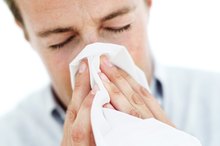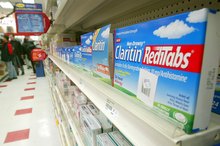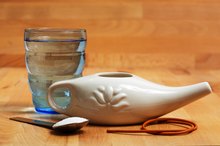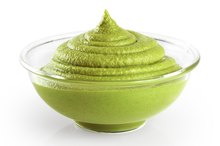Over-the-Counter Treatments for Post Nasal Drip
Most people probably felt it at one time or another. A lump in the back of the throat that doesn't go away when they swallow or clear their throat and sometimes comes with a stuffy nose or an itchy throat. Post nasal drip is a common symptom of a cold or allergies that occurs when the nasal membranes become obstructed 2. This obstruction causes the mucus to drain down to the throat instead of going through the nose, where it can be extracted by blowing your nose. Although it's not life-threatening, it is often annoying and can cause a sinus infection if not treated over a period of time. There are a number of over-the-counter medications available to relieve post nasal drip 2.
If you are experiencing serious medical symptoms, seek emergency treatment immediately.
Oral Decongestants
The most common decongestant is pseudoephedrine. Sudafed, Actifed and Comtrex all contain pseudoephedrine. Oral decongestants reduce the swelling and inflammation of the nasal passages and help to relieve the obstruction that is causing the post nasal drip 2.
Antihistamine Decongestant
How to Dry Out a Sinus That Is Congested With Mucus
Learn More
Histamines are natural chemicals released by the body when after coming into contact with an allergen. The reaction that occurs can cause post nasal drip 2. Antihistamines work to stop the reaction and reduce congestion.
Nasal Spray Decongestant
Decongestant nasal sprays are applied directly to the nasal passages through a bulb-tip applicator. One of the most common nasal spray decongestants is Oxymetazoline (commercially sold as Afrin) or a saline spray. The sprays shrink the blood vessels in the nasal passages to improve breathing and promote drainage.
Nasal Lavage
Alternatives to Decongestants
Learn More
Nasal lavage is the process of naturally draining the nasal passages. The most common form of nasal lavage is utilizing the neti pot. Water is passed through each nostril with the bulb-tip of a pot. The tip is inserted into the nostril on one side as you tip your head, water drains out of the other side. Nasal lavage dilutes mucus or forces it out of the nasal passages. Blowing your nose afterwards can remove any extra water or mucus.
- Nasal lavage is the process of naturally draining the nasal passages.
- The tip is inserted into the nostril on one side as you tip your head, water drains out of the other side.
Mucus Thinning Agents
Mucus thinning agents, such as Mucinex, contain agents that thin the mucus and prevent pooling at the back of the nose and throat to help you clear your throat and nasal passages. Drinking ample fluids, primarily water, can help to thin mucus and help a mucus-thinning agent to work in a more efficient manner.
Related Articles
References
- Medicine.net: Chronic rhinitis
- U.S. National Library of Medicine. Medline Plus. Allergic Rhinitis. Updated 05/09/17.
- Yu JL, Becker SS. Postnasal drip and postnasal drip-related cough. Curr Opin Otolaryngol Head Neck Surg. 2016;24(1):15-19. doi:10.1097/MOO.0000000000000226
- Varshney J, Varshney H. Allergic Rhinitis: An Overview. Indian J Otolaryngol Head Neck Surg. 2015;67(2):143-149. doi:10.1007/s12070-015-0828-5
- Pinto JM, Jeswani S. Rhinitis in the geriatric population. Allergy Asthma Clin Immunol. 2010;6(1):10. doi:10.1186/1710-1492-6-10
- Bhargava D, Bhargava K, Al-Abri A, Al-Bassam W, Al-Abri R. Non Allergic Rhinitis: Prevalence, Clinical Profile and Knowledge Gaps in Literature. Oman Med J. 2011;26(6):416-420. doi:10.5001/omj.2011.106
- Kaliner MA. Classification of Nonallergic Rhinitis Syndromes With a Focus on Vasomotor Rhinitis, Proposed to be Known henceforth as Nonallergic Rhinopathy. World Allergy Organ J. 2009;2(6):98-101. doi:10.1097/WOX.0b013e3181a9d55b
- Scarupa MD, Kaliner MA. Nonallergic rhinitis, with a focus on vasomotor rhinitis: clinical importance, differential diagnosis, and effective treatment recommendations. World Allergy Organ J. 2009;2(3):20-25. doi:10.1097/WOX.0b013e3181990aac
- Morice AH. Post-nasal drip syndrome--a symptom to be sniffed at? Pulm Pharmacol Ther. 2004;17(6):343-345. doi:10.1016/j.pupt.2004.09.005
- Kariyawasam HH, Scadding GK. Chronic Rhinosinusitis: Therapeutic Efficacy of Anti-Inflammatory and Antibiotic Approaches. Allergy Asthma Immunol Res. 2011;3(4):226-235. doi:10.4168/aair.2011.3.4.226
- Vaezi MF, Hagaman DD, Slaughter JC, et al. Proton Pump Inhibitor Therapy Improves Symptoms in Postnasal Drainage. Gastroenterology. 2010;139(6):1887-1893.e1. doi:10.1053/j.gastro.2010.08.039
- Dzieciolowska-Baran E, Teul-Swiniarska I, Gawlikowska-Sroka A, Poziomkowska-Gesicka I, Zietek Z. Rhinitis as a Cause of Respiratory Disorders During Pregnancy. Adv Exp Med Biol. 2013;755:213-220. doi:10.1007/978-94-007-4546-9_27
- Sylvester DC, Karkos PD, Vaughan C, et al. Chronic Cough, Reflux, Postnasal Drip Syndrome, and the Otolaryngologist. Int J Otolaryngol. 2012;2012:564852. doi:10.1155/2012/564852
- Kasper, Dennis L.., Anthony S. Fauci, and Stephen L.. Hauser. Harrison's Principles of Internal Medicine. New York: Mc Graw-Hill Education, 2015. Print.
- Kliegman, Robert M., Bonita Stanton, St Geme III Joseph W., Nina Felice. Schor, Richard E. Behrman, and Waldo E. Nelson. Nelson Textbook of Pediatrics. 20th Edition. Philadelphia, PA: Elsevier, 2015. Print.
- U.S. National Library of Medicine. Medline Plus. Allergic Rhinitis. Updated 05/09/17.
Writer Bio
Shemiah Williams has been writing for various websites since 2009 and also writes for "Parle Magazine." She holds a bachelor's degree in business and technology and a master's degree in clinical psychology. Williams serves as a subject matter expert in many areas of health, relationships and professional development.









